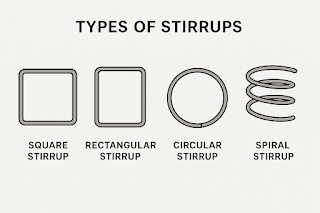Types of Stirrups in Construction
- Get link
- X
- Other Apps
Stirrups in reinforced concrete construction serve as a critical part of structural integrity. They are a closed loop of the reinforcement bars utilized to prevent the main longitudinal reinforcement (rebar) from shifting, prevent shear failure, and enhance ductility. Stirrups serve a critical purpose in beams, columns, and footings by resisting diagonal shear and torsion and inhibiting buckling of the main bars.
This article details the types of stirrups in construction, their shapes, uses and importance.
Description:
It is the most popular type of
stirrup, made in rectangular shape and closed by folding over the ends.
Applications:
Used in beams and columns with
rectangular cross-sections mostly. It provides a uniform stress distribution
and houses the core concrete.
Features:
• Easy to manufacture and install
• Suitable for most typical
structural members
• Offers good shear resistance
Description:
Shape similar to the rectangular
stirrup but with the same sides, creating a perfect square.
Applications:
Used in square cross-sectional
columns or near-square shapes columns or beams.
Features:
- Ideal for symmetrical
structural elements
- Ensures equal confinement in
all directions
Description:
Shaped into a closed circular
loop.
Applications:
Used in circular columns, piers,
or piles, where main longitudinal reinforcement must be retained around a circular
core.
Features:
• gives
uniform confinement of concrete
• Provides improved performance
under axial loads and seismic forces
Description:
A continuously wrapped
reinforcement bar in a helical form.
Applications:
Used in circular columns and
piles, particularly in seismic areas.
Features:
• Offers better confinement than
circular stirrups
• Improves load-carrying capacity
• Improves ductility and
toughness of concrete
Description:
Diamond-shaped stirrups are
inserted at an angle of 45 degrees to the vertical. They appear like turned
squares or rhombuses.
Applications:
Utilized in regions of heavy
shear, torsion, or special architectural design requirements.
Features:
• Resists
diagonal tension
• Virtually used in deep transfer beams or cantilever beams
Description:
An open-looped stirrup, typically
U-shaped, with hooks at each end for anchorage.
Applications:
Utilized in slabs, cantilever
beams, or in zones of low stress where a complete closed stirrup is
unnecessary.
Features:
• Easy
to fix in heavy reinforcement
• Not
advised in heavy shear or torsion regions
Description:
Though technically distinct,
lateral ties in columns play a role akin to stirrups by restraining
longitudinal bars.
Applications:
Employed in column reinforcement,
particularly square and rectangular columns.
Features:
• Takes
the main buckling of main bars
• Improves
seismic performance
• Ensures
composite action of reinforcement and concrete
Description:
Stirrups with sloping sides or
curved angles in lieu of plane 90-degree corners.
Applications:
Employed in special design
situations to enhance anchorage or accept non-conventional beam geometries.
Features:
• Increases
shear resistance
• Takes
better with bar layout
9. Multi-Legged Stirrups (2-leg,4-leg, 6-leg, etc.)
Description:
These are more than one closed
loop tied in a group. Example:
• 2-legged
stirrup: One closed loop
• 4-legged
stirrup: Two loops joined in a square or rectangular area with four corners
• 6-legged
stirrup: Three loops or more for confining wider beams or columns
Applications:
Utilized in massive columns and
beams where several bars must be confined.
Features:
• Takes
good confinement in multi-bar arrangements
• Appropriate
for heavily loaded or large cross-section members
Description:
Custom stirrups with a
combination of shapes (e.g., L-shaped, T-shaped, or irregular geometries) to match
atypical beam or column shapes.
Applications:
Applied in architecturally
sophisticated structures, non-rectangular columns, or beams of variable depths.
Features:
• Engineered according to
engineering specifications
• Flattering constructability in
non-standard configurations
The right selection of stirrup
type is based on:
• Structural member's shape and
size
• Type and extent of loads
(axial, shear, torsion)
• Seismic design requirements
• Fabrication and construction
ease and simplicity
Correct stirrup detailing and
positioning:
• Avoid structural failure caused
by shear
• Enhance ductility and load
transfer
• Improve serviceability and
crack control
- Get link
- X
- Other Apps



.png)
Comments
Post a Comment